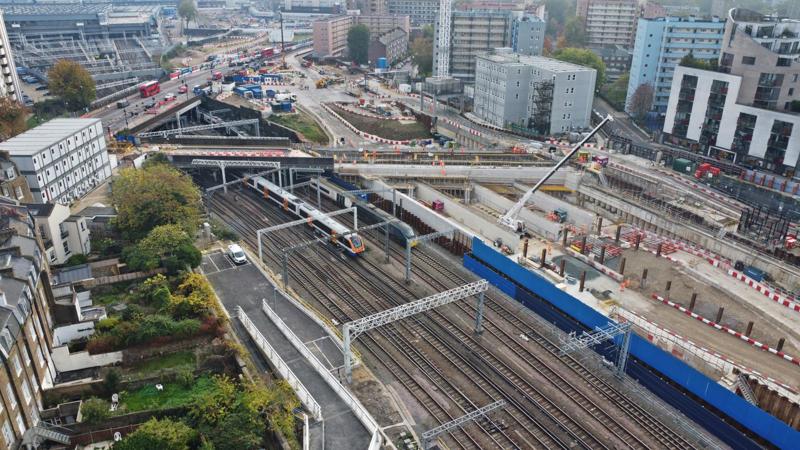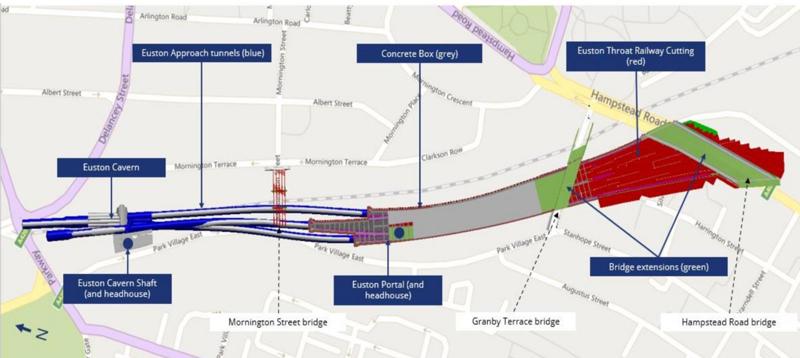The go-ahead was given late last year for work to resume on turning London Euston into the southern terminus of HS2. But, as Chris Howe discovers, activity at the site was never actually stopped…
In this article:
The go-ahead was given late last year for work to resume on turning London Euston into the southern terminus of HS2. But, as Chris Howe discovers, activity at the site was never actually stopped…
In this article:
- The HS2 Euston site remains largely empty after demolition, causing disruption and uncertainty for residents and businesses.
- Construction activity continued on utilities, approach works, and temporary community spaces, despite uncertainty over the station’s future.
- Tunnelling from Old Oak Common to Euston was approved in 2024, but station funding and plans remain unclear.

In February 2023, work on the new HS2 station at Euston was paused - after what the Department for Transport called “inflationary pressures” led to the budget rising sharply from around £2.6 billion to £4.8bn.
The general public could therefore have been forgiven for thinking that work on the new station had stopped.
But pausing work on an active construction site of this size is not straightforward. Over the past two years, the Mace Dragados joint venture responsible for building the station and the approach has continued to carry out work - including the demolition of a number of buildings, leaving behind a large empty space measuring almost 1km in length within central London.
This creation of an empty plot surrounded by hoardings, with the associated loss of access, is not only inconvenient, it is unsightly. It can also negatively impact local business (RAIL 1024).
The only silver lining for businesses and local residents was that there was at least an end in sight, and that the new station, once built, would enhance the area and provide improved east-west access for pedestrians. It was also anticipated that the new station and over-site-development would kick-start the regeneration of the area around Euston.
Nor was work on the station and the approach limited to the confines of the immediate site. Utility diversions were taking place, while other areas not directly required for the station itself were also subsumed within the HS2 work site.
While construction of the new station itself had not begun, work was progressing on the approach into the station and on the construction of a new Traction Sub Station (TSS) building for the London Underground.
This building will replace an existing Leslie Green-designed building on Melton Street, which previously housed the TSS equipment and which is set to be demolished to make way for the new station.
The new building was dubbed ‘the sugar cube’, owing to the white tiles which were supposed to adorn the exterior of the cube-shaped structure. However, although the internal fitting-out is still going ahead, the pause means that the concrete box will (for the time being) not be covered in tiles. Instead, the exterior has been painted until a decision is made on the fate of Euston itself.
Other works (referred to as ‘no regrets’ and ‘meanwhile’ works) are continuing around the station, in order to return some of the streets to a habitable condition for residents and businesses.
‘No regrets’ work (essential work that will not need to be redone at a later date) includes restoring vehicular access to Cobourg Street, which had been used by construction vehicles to access the site. The road was also resurfaced.
And a ‘meanwhile’ programme (useful work that would need to be done anyway, pending a decision) is under way to temporarily return parts of the site for public use. This includes Euston Square Gardens west, which has been transformed into a community space, with planting and benches.
Elsewhere, utility diversion works are still scheduled to continue, with work to move a gas main on Drummond Street set to begin in early 2025.
Utility diversions are also taking place along Hampstead Road - a vital main road which runs in a southerly direction over the West Coast Main Line and (currently) through the HS2 site.
The existing bridge over the WCML will have to be extended in order for the approach into the new station to be constructed. To that end, work has taken place throughout 2024 and will continue until spring 2025 to temporarily divert utilities. This required a number of lane and road closures.
Work to extend Granby Terrace bridge, which connects Hampstead Road to Park Village East, is also ongoing. Here, the existing bridge over the WCML is also being extended to make way for the approach into the new station. As work had begun prior to the pause, it was only logical to complete the bridge extension.Construction of the new station and approach is, of course, only one piece of the puzzle, and there have been numerous reports about the status of tunnel construction.
In September 2024, The Times reported sources saying that the Prime Minister had until the end of 2024 to decide if tunnelling towards Euston should commence or not.
The issue for Euston Tunnel is that tunnelling will commence from the Old Oak Common station box. Spoil will have to be transported out, and tunnel rings and materials transported in, via the box - all while it is in the process of being fitted out to become a station.
To facilitate the transportation of spoil and materials, an 835-metre-long logistics tunnel has already been constructed. The Atlas Road logistics tunnel connects Atlas Road logistics hub to the eastern section of the Old Oak Common station site, and will be used to transport spoil and materials for Euston Tunnel when tunnelling commences.
It will house a conveyor system that will transport the excavated spoil to the Willesden Euroterminal, from where it will be moved via rail to be used for land reclamation.
Although the pause at Euston meant that tunnelling was also paused, some work continued on the required ventilation shafts, of which there will be two.
The ground for the Adelaide Road shaft, located alongside the WCML to the north-west of Euston, was excavated down to the level of the existing tracks. However, no work to excavate the shaft itself has taken place.
Meanwhile, excavation of the Canterbury Works shaft in South Kilburn had reached base level before work was brought to a ‘safe stop’ in September, and no further work has taken place since. Work on the Euston Cavern head house was also paused.
Despite the fact that it was not known for certain when (or if) HS2 would reach Euston, the two tunnel boring machines (TBMs) which will construct the 7.2km-long (4.5-mile) twin bore tunnel were delivered to Old Oak Common last year.

Sections of the TBMs were then subsequently assembled within the station box, and the two TBMs - named Madeleine (after Madeleine Nobbs, the former president of the Women’s Engineering Society) and Karen (after Karen Harrison, the first female train driver in the UK who was based out of Old Oak Common depot) - were unveiled in December. They will begin their subterranean journey later this year.
After much speculation, Chancellor Rachel Reeves had given the go-ahead for tunnelling to commence during her Autumn Budget, on October 30.
However, no announcement was made about the station itself. Instead the budget only states that funding the tunnels will catalyse “private investment into the station and local area”.
Although funding for the tunnelling has been assured, questions still remain about the station and approach.
HS2 sources seem confident that that grade-separated approach will be constructed, yet there is little information about when work will recommence on the Euston site.
Constructing the complex junction arrangement will require the excavation of a large cavern and three separate tunnels. Because of the nature of the construction method, the spoil will have to be removed from the Euston end, which could pose challenges for engineers.
Nevertheless, despite how complex an undertaking it may be, there seems to be broad agreement that the approach must be grade-separated. Otherwise, capacity at the new terminus would be permanently constrained, no matter how many platforms are constructed.
The design of the approach is such that trains heading south on the Up line will not conflict with those heading north.
This will be achieved by having the Up line tunnel split into two within the cavern. The two separate Up line tunnels will then emerge either side of the single Down line tunnel entrance. Once the trains exit the tunnels, they will be able to access any one of the platforms via a set of high-speed cross-overs.
Work on the approach tunnels and cavern had initially been expected to begin in 2023, but the pause to Euston station could now see construction of the approach delayed by at least two years.
Although inflationary pressures were blamed for the sharp increase in cost, the estimated costs for Euston had been rising steadily since 2020.
The initial phased design would have delivered 11 platforms, but this was cut back to a ten-platform single phase design in November 2020. Despite this design change, which in theory would have simplified delivery, costs still rose from £2.2bn to £2.6bn.
The designs were changed again in December 2021, when HS2 Ltd was instructed to integrate more closely with Network Rail’s plans to redevelop the existing station. This effectively wrote off £106 million which had already been spent developing plans for the new station.
By the end of 2022, HS2 Ltd had already spent £2bn on preparations for the new station and approach, which included land purchase and design work.
Before last October’s Budget, there had been widespread consensus among industry experts that terminating trains at Old Oak Common indefinitely would not be a viable option, with estimates for the capacity to terminate trains at Old Oak ranging from just six trains per hour in each direction to a maximum of ten.
Further to this, there will be fewer options for onward travel from Old Oak compared with Euston.
Many east-west journeys will be significantly quicker and easier changing at Old Oak Common for Elizabeth line services.
However, Old Oak Common will provide poor north-south connectivity, and there is the possibility for an expensive journey into central London for those who feel they need to travel from the station into the capital by taxi.
It therefore appears imperative that construction of the new terminus begins at the earliest possible opportunity, but as yet there are few details about what the station will look like.
All we know at present is that plans are being taken forward for a six-platform design, which will provide capacity for ten trains per hour in and out of the new terminus.
Further details regarding funding, the potential for over-site development, and when the station will open may not be known until details of Labour’s Spending Review are released, expected in spring 2025.
For a full version of this article with more images and data, Subscribe today and never miss an issue of RAIL. With a Print + Digital subscription, you’ll get each issue delivered to your door for FREE (UK only). Plus, enjoy an exclusive monthly e-newsletter from the Editor, rewards, discounts and prizes, AND full access to the latest and previous issues via the app.
Login to continue reading
Or register with RAIL to keep up-to-date with the latest news, insight and opinion.


















Login to comment
Comments
No comments have been made yet.